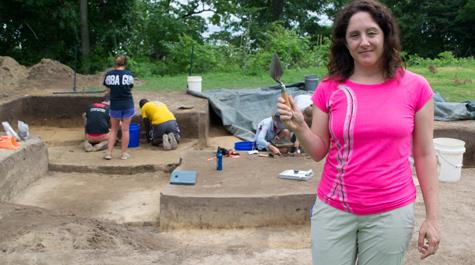Intriguing internships: archaeology at a site visited by John Smith
Many William & Mary undergraduate and graduate students take advantage of the summer months to broaden their skills and gain experience in their chosen fields through internships. This story is the third in a series that explores some of the intriguing internships that students are engaged in this summer. — Ed.
Ariana Golay-Dubnansky began her studies at William & Mary in 1999 and finished them up this summer with an archaeological field school internship at the site of an Indian village visited by John Smith.
She resumed her studies this past fall and will get her undergraduate degree in August. In the years that she was away from William & Mary, she got married, had a family and traveled the world.
A European studies major, she picked the field school experience in part because she needed one more credit hour to fill out the requirements to graduate in August.
“When I came back, I had done most of my major requirements, so now I could focus on what was most interesting,” she said.
Golay-Dubnansky joined a dozen or so undergraduates and graduate students working at the 2015 field school under the direction of Martin Gallivan, professor of anthropology at William & Mary. Each day during the summer, she drove the hour and a half from Virginia Beach to the Yorktown Naval Weapons Station where she picked up a trowel and worked to excavate the remains of Kiskiack, a large Indian town that was part of the chiefdom of Powhatan.
“Most people know what an archaeologist is,” she said, “but most people don’t know what an archaeologist does.”
What an archaeologist does, she found, is remove dirt very slowly, carefully and strategically. Even sifting — the screening of earth taken from the dig — requires some skill.
“You’d think that you just dump dirt onto the sifter and shake it, but you actually have to train your eye to look for things,” Golay-Dubnansky explained. “I found a little triangular shaped thing. It was so small, I thought there was no way it could be anything remotely used by the natives. It ended up being a projectile point.”
Golay-Dubnansky is considering a number of post-baccalaureate options, including graduate school and education programs. She said she expects the skills and concepts she learned on the Kiskiack internship will be put to use.
“I think it would be fun to use archaeology to teach students a more in-depth look at a topic,” she said. “It’s like learning a new language, almost.” Skip to main content
Skip to main content

